The History of St David's Hall
INTRODUCTION
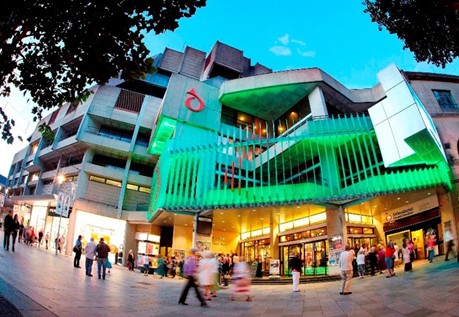
St David’s Hall – The National Concert Hall &
Conference Centre of Wales
St David’s Hall is the National Concert Hall and Conference Centre of Wales located in the heart Cardiff at The Hayes.
Since opening in 1982, millions of concert-goers have flocked to the venue to experience the auditorium’s awe-inspiring sound, which continues to host the world’s best orchestras.
The Hall hosts illustrious events such as the BBC Cardiff Singer of the World, the International Concert Series, the Welsh Proms and the British Academy Cymru Awards to name just a few.
As well as hosting world-class classical music, ballets and opera, the auditorium has had a hugely diverse array of stars grace its stage including Sir Anthony Hopkins, U2, Adele, Sir Elton John, Ray Davies, Johnny Cash, Tina Turner, Miles Davis, Joe Calzaghe, Brian Wilson and Sir Ranulph Fiennes amongst many others.
Countless comedians have also trodden the boards, whilst the L3 Lounge has provided exposure for the burgeoning careers of Amy Winehouse and Jamie Cullum.
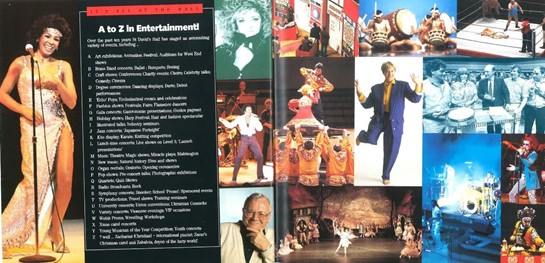
The A-Z in Entertainment!
Centre-page spread of the 10th anniversary souvenir programme
The venue is also a highly sought after conference and community space, and provides a vital platform for youth and amateur talent.
St David’s Hall is owned, managed and funded by Cardiff Council with support from the Arts Council of Wales. Annually it hosts approximately 300 performances attended by audiences in excess of 250,000. It continues to be a leading venue in the cultural and continuing development of Cardiff into one of Europe’s most cosmopolitan cities.
In October 2016, leading media website Business Insider UK ranked St David’s Hall ninth in the Top 10 world’s best sounding concert halls ahead of prestigious venues like the Royal Albert Hall and Sydney Opera House.
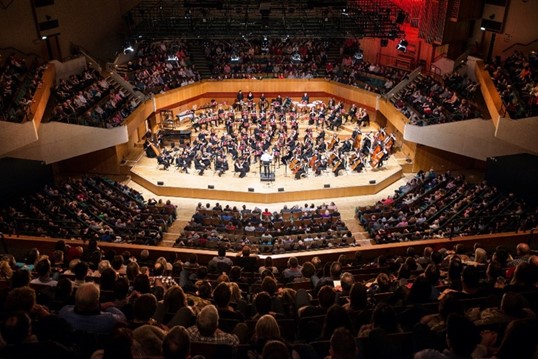
A full house at the Hall!
THE CONSTRUCTION
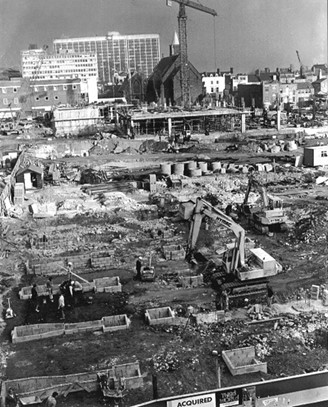
Construction begins on St David’s Hall in the late 1970s
Architects Seymour Harris Partnership had the tricky task of fitting a major 2,000-seat, acoustically perfect auditorium with surrounding dressing rooms, bars, foyers, offices and conference facilities into a cramped city centre space. The area was so confined that they had to fit the development within the footprint of the already planned and partly built St David’s Shopping Centre.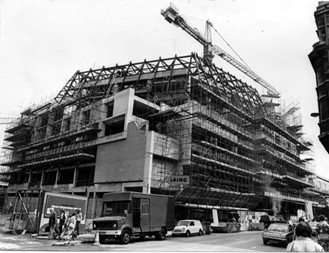
Early Construction
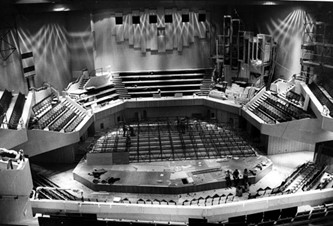
The auditorium taking shape!
Consequently, the main contractors John Laing & Son Construction Ltd had to ensure that every inch of space was used effectively and it left the concert hall with a highly unusual shape. Its architecture is a complex style of late Brutalism with its angular grey concrete looking unmistakably 1970s/1980s modernist new build.
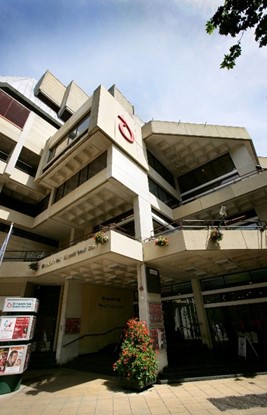
The Hall’s Brutalist architecture
Public and political desire for such a venue dated back to the 1950s. Yet, the long wait was more than worthwhile, and the Hall took only five years from conception to completion.
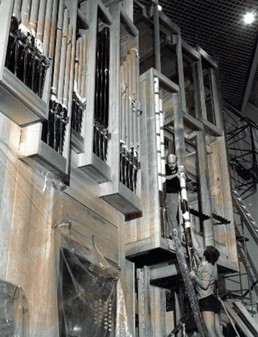
Organ construction
THE EARLY DAYS
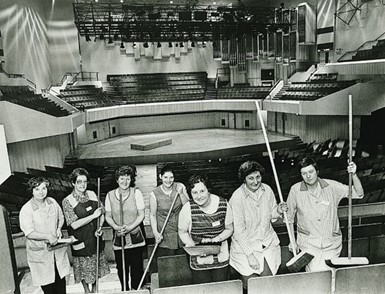
Cleaning staff in the Hall’s early days
A staggering 21,000 people flooded through the doors during a special open day on Monday 30 August 1982, and the following week came the first live performance with a free rehearsal from the Cardiff Polyphonic Choir on Wednesday 8 September 1982.
The first paid performance was the Central Band of the Royal Air Force closely followed by a recital from American organist, Carlo Curley. Soon after, the Hall hosted its first pop concert on Thursday 16 September 1982 with a sold out show from British soul group, Hot Chocolate. Demand for tickets was that high that they added a matinee performance that same day.
St David’s Hall was an instant success with concert-goers. Queues at the Box Office in the initial months often extended to more than 100 yards along The Hayes. Concerts from Cliff Richard, Oscar Peterson, the London Symphony Orchestra, Neil Sedaka and Showaddywaddy also sold out within the opening weeks. As the Western Mail reported: “The response of the public, staff and performers is unanimous…it’s a hit!”
Iconic Welsh artists like Tom Jones and Shirley Bassey enjoyed performing at the venue for several nights during the 80s, whilst Manic Street Preachers first honed their craft whilst busking outside the front entrance as teenagers.
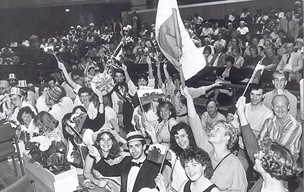
The first Welsh Proms, 1986
THE OFFICIAL OPENING
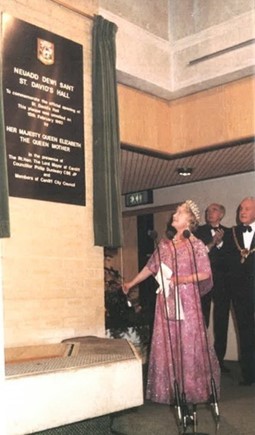
The Queen Mother unveils the official opening plaque
The National Concert Hall of Wales had already been thriving for several months when it was given the Royal seal of approval. On Tuesday 15 February 1983, the Queen Mother officially opened St David’s Hall with the unveiling of a commemorative plaque located next to the Level 3 Stage.
At the ceremony, Her Majesty said: “This exciting development will add greatly to the quality of life for the city of Cardiff and the people of the Principality.”
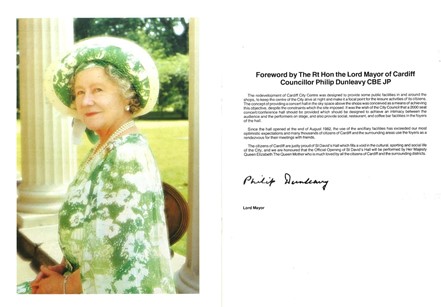
A foreword by the Lord Major, Cllr Philip Dunleavy in the
official opening souvenir programme
The official opening concert featured the BBC Welsh Symphony Orchestra, Petula Clark, The Cory Band, Pontarddulais Male Choir and Owain Arwel Hughes. Guest speakers for the evening were Welsh bass-baritone, Sir Geraint Evans and Welsh actress, Angharad Rees. There was also a reading from Swansea poet, Harri Webb and the event was broadcast live on HTV Wales.
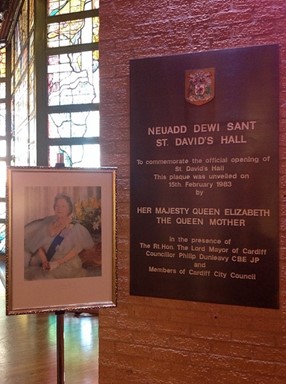
The official opening plaque remains displayed on Level 3
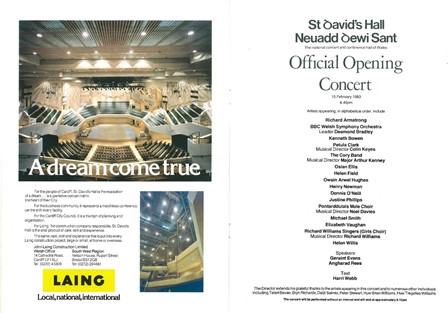
The line-up for the official opening concert
St David’s Hall truly transformed the artistic life of the Welsh capital. As the official programme said: “For the people of Cardiff, St David’s Hall is the realisation of a dream…a superlative concert hall in the heart of their city.”
THE STUTTGART WINDOW
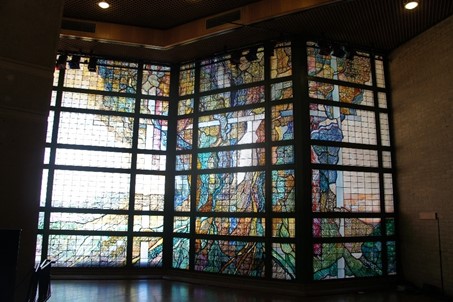
The Stuttgart Window on Level 3
Next to the official opening commemorative plaque is an ornate stained glass window designed by Hans Gottfried von Stockhausen, which was donated as a gift from Cardiff’s twin town Stuttgart. It was unveiled in 1984 by Stuttgart’s Bürgermeister, Hansmartin Bruckmann (a loose equivalent to our Mayor). The design features a Welsh landscape with its sprawling valleys and flowing rivers, but there’s also a bit of Welsh culture hidden within – see if you can spot the rugby posts!
In front of the window is the Level 3 Stage, which regularly hosts comedians, folk concerts in the Roots Unearthed series, Cardiff’s very own Capital City Jazz Orchestra and contemporary music performances in the nightmusic programme; plus occasional live broadcasts from BBC Radio Wales.
RON WATKISS BUST
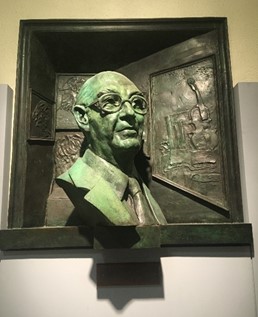
Front foyer bust of Councillor Ron Watkiss CBE
Councillor Ron Watkiss (21.05.1920 – 21.04.1991) was hugely influential in the creation of the National Concert Hall of Wales, as well as much of the improvements made to Cardiff’s city centre from the late 1960s to early 1980s.
Watkiss became Mayor of Cardiff in 1981 and was awarded a CBE for his services to the Welsh capital including his greatest legacy St David’s Hall along with the original St David’s Shopping Centre – later replaced by the much larger St David’s Dewi Sant Shopping Centre. He is proudly immortalised with a bronze portrait bust situated in the venue’s front foyer.
It was sculpted by Chris Kelly, and presented by Watkiss’ friends and associates. It was unveiled on Wednesday 20 May 1992 just under a year after Watkiss’ death by the Rt Hon Lord Mayor of Cardiff, Councillor Sainsbury to coincide with the Hall’s 10-year anniversary celebrations.
This corner of the front foyer is now reserved for the promotional purposes of the venue’s orchestra-in-residence, the BBC National Orchestra of Wales.
PRINCE CHARLES BUST
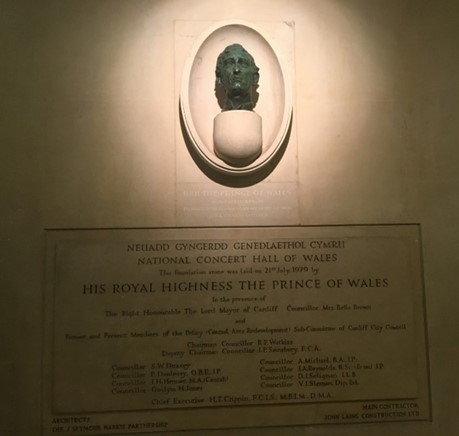
Front foyer bust of Prince Charles
Located on the left of the venue’s front foyer, you will notice a bust of His Royal Highness, Prince Charles (the Prince of Wales) presented to the Hall by the Contemporary Arts Society for Wales. It was created by British sculptor, Ivor Roberts-Jones (whose name is incorrectly stated as ‘Ivor Robert Jones’ on the inscription).
The busts sits within a niche designed by one of the leading figures in the Welsh architectural scene, Ivan Dale Owen of Merthyr Tydfil, who also designed the bust of Richard Burton at Cardiff’s New Theatre.
Below the niche is a foundation stone that was laid by Prince Charles on 21 July 1979 in the presence of the Lord Mayor (Councillor Bella Brown) and other leadingrepresentatives of Cardiff Council including Councillors Watkiss and Sainsbury.
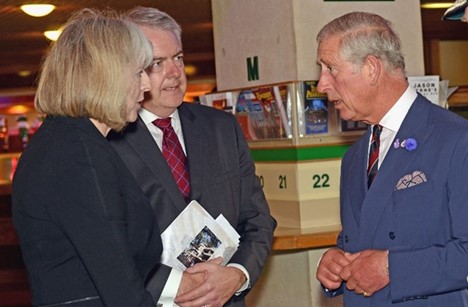
Home Secretary (and future British Prime Minister) Theresa May & Wales’
First Minister Carwyn Jones chat with Prince Charles at the
National Police Memorial Day, September 2013
PRINCESS DIANA BUST
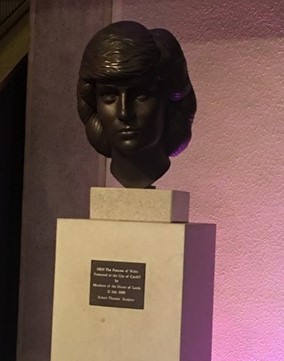
Front foyer bust of Princess Diana
Directly in the centre of the Hall’s front foyer near the escalator is a bronze bust of Princess Diana created by Treorchy sculptor, Robert Thomas. It was completed in 1987 and presented to the city of Cardiff by Members of the House of Lords on Friday 21 July 1989. Amongst Thomas’ other famous works is the full-length statue of Labour MP and founder of the National Health Service, Aneurin Bevan on Queen Street.
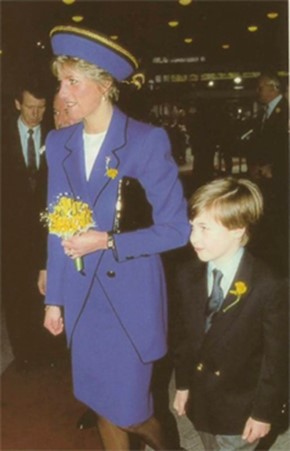
Princess Diana accompanies Prince William on his first royal
engagement at the Hall, St David’s Day 1991
The Princess of Wales visited St David’s Hall several times. On Friday 1 March 1991, she brought her son Prince William to the Hall on his first public engagement. Tragically, Princess Diana died in a car crash in Paris on Sunday 31 August 1997 at the age of just 36.
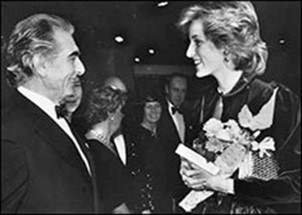
Acclaimed opera singer, Sir Geraint Evans meets Princess Diana on the
Hall’s official opening day, February 1983
